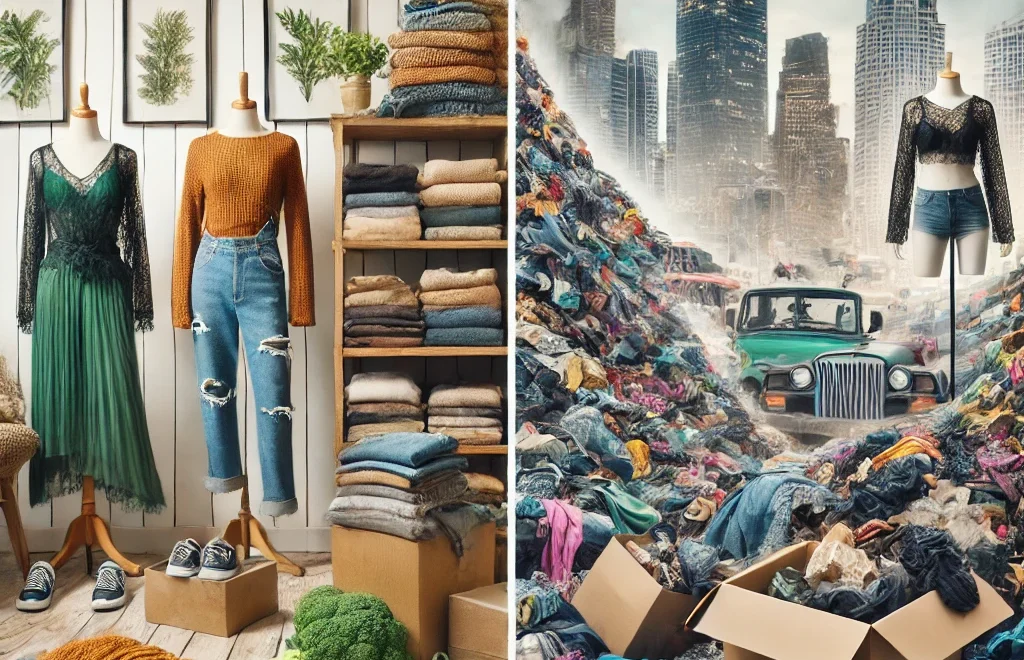In recent years, the fashion industry has seen a significant shift in consumer behaviour. While fast fashion has long dominated the scene, the rise of slow fashion is challenging the status quo, offering a sustainable alternative for eco-conscious shoppers. As more individuals become aware of the environmental and social impacts of mass-produced, cheap clothing, slow fashion has emerged as a solution for those seeking ethical, durable, and thoughtfully made garments. In this blog, we explore the growing slow fashion movement and how it’s countering the fast fashion trend for a more sustainable future.
The UAE leads the way in the slow fashion market, with sustainable fashion accounting for an impressive 47.39% of its apparel market, generating $5 billion in revenue. Despite a notable fast fashion market share of 22.46%, this growing demand for slow fashion highlights a strong consumer preference for eco-friendly, ethically produced clothing.
What is Slow Fashion?
Slow fashion is an approach to clothing that focuses on sustainability, quality, and ethical production. Unlike the fast fashion model, which prioritizes quick turnover and low-cost production, slow fashion emphasizes the longevity of garments, ethical sourcing, and reducing the environmental impact of clothing production. It advocates for thoughtful consumption, encouraging consumers to buy less, invest in higher-quality pieces, and prioritize brands that care about their environmental and social responsibilities.
The Negative Impacts of Fast Fashion
The fast fashion industry, characterized by rapid production cycles and cheap, disposable clothing, has long been criticized for its negative environmental and social effects. Here’s why fast fashion is under scrutiny:
Environmental Impact: Fast fashion is one of the largest contributors to environmental degradation. From textile waste to overuse of water and energy resources, the production processes are incredibly resource-intensive. The rapid pace of production leads to a “throwaway culture,” with garments often ending up in landfills after only a few uses.
Labor Exploitation: Fast fashion relies heavily on low-wage workers, often in developing countries, where workers face unsafe working conditions, long hours, and low pay. This unethical practice of outsourcing to factories with poor labor standards has been a significant concern for consumers and human rights advocates.
Quality vs. Quantity: Fast fashion promotes quantity over quality. Garments are produced cheaply and quickly, which results in poor-quality materials and craftsmanship. As a result, clothing items wear out quickly, leading consumers to dispose of them and buy more, fueling a never-ending cycle of consumption.
How Slow Fashion is Changing the Industry
The slow fashion movement is gaining traction, offering consumers an alternative to the harmful practices of fast fashion. Here are some key aspects of slow fashion and how it’s reshaping the industry:
Emphasis on Quality Over Quantity
In slow fashion, quality takes precedence over quantity. Instead of purchasing a large number of cheaply made items, consumers are encouraged to invest in well-crafted garments that will last longer. This shift towards durable clothing means fewer purchases, which ultimately reduces waste and consumption. Slow fashion brands focus on using high-quality materials such as organic cotton, linen, and sustainable fabrics, ensuring that each piece is made to last.
Ethical and Transparent Production
Slow fashion brands prioritize ethical production processes that respect workers’ rights and ensure fair wages. These brands often have a transparent supply chain, providing consumers with information about where and how their clothes are made. Ethical practices in the garment industry include safe working conditions, fair wages, and respect for human rights.
Sustainable Materials and Fabrics
A cornerstone of the slow fashion movement is the use of sustainable materials. Unlike the synthetic fabrics used in fast fashion, slow fashion brands often use organic cotton, hemp, bamboo, and recycled fibers. These materials have a lower environmental impact and are biodegradable, reducing waste. Many brands also focus on closed-loop systems, where garments can be recycled or upcycled at the end of their life cycle.
Supporting Local and Small-Scale Production
Many slow fashion brands focus on local and small-scale production methods, reducing the carbon footprint associated with long supply chains and overseas manufacturing. By working with artisans and local producers, these brands foster fair trade practices and support smaller communities, creating more meaningful economic opportunities and preserving traditional craftsmanship.
Timeless Styles Over Trend-Driven Fashion
Slow fashion champions timeless, versatile pieces that can be worn for years, rather than the rapidly changing trends of fast fashion. By creating classic designs that transcend seasons, slow fashion encourages consumers to build a wardrobe of enduring pieces rather than succumbing to the pressure of constantly buying the latest trends.
Second-Hand and Upcycled Fashion
In addition to buying new, slow fashion embraces second-hand shopping and upcycled fashion. Vintage clothing and pre-loved garments offer an eco-friendly alternative to purchasing new. By reusing and repurposing existing clothing, the slow fashion movement helps reduce waste and promotes a more sustainable approach to fashion.
Benefits of Slow Fashion
The rise of slow fashion comes with several benefits that make it a desirable alternative to fast fashion:
Environmental Impact: By focusing on sustainable materials, eco-friendly production methods, and longevity, slow fashion helps reduce the fashion industry’s environmental footprint.
Improved Worker Rights: Slow fashion brands prioritize fair wages, safe working conditions, and ethical treatment of workers, improving the livelihoods of those in the garment industry.
Consumer Awareness: Slow fashion promotes a more thoughtful and mindful approach to shopping. Consumers are encouraged to consider the true cost of their clothing choices and to invest in pieces that align with their values.
Long-Term Savings: Although slow fashion garments may come with a higher price tag upfront, their durability and timeless appeal make them a better investment in the long run. Consumers can save money over time by purchasing fewer items that last longer.
The Future of Slow Fashion
As the environmental and social impacts of fast fashion continue to gain attention, the slow fashion movement is set to grow. Consumers are becoming more conscious of where their clothing comes from and how it affects the world around them. With the rise of slow fashion, there is hope for a more sustainable and ethical fashion industry that puts people and the planet first.
Conclusion: Embrace Slow Fashion for a Better Future
The rise of slow fashion is a powerful response to the harmful practices of fast fashion. By focusing on quality, sustainability, and ethical production, slow fashion encourages consumers to make more conscious choices and support brands that are committed to positive change. As the movement continues to gain momentum, we can look forward to a fashion industry that values longevity, fairness, and environmental responsibility.By making the switch to slow fashion, we are not only countering the fast fashion trend but also contributing to a more sustainable and ethical future for the planet and the people who create our clothes.

Aditya kumar
Senior Associate


Leave a Comment